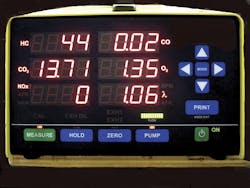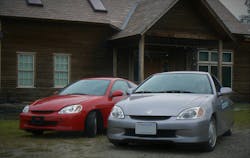Before you start reading this article, a relatively new acronym is xEV. This is what ASE calls a hybrid, plug-in hybrid, and pure electric vehicle (HEV, PHEV, and EV). Almost every electric vehicle training class you attend at a hotel ends up being a safety class, plus some tips. That is not a complaint about the industry, but an observation. I hear from many well-trained technicians that they want more. What do you need? Let's start with a five-gas analysis class. Do you know the science that started the move to cleaner cars in model year 1975? If not, it's time to study chemistry again or maybe for the first time. More about that later.
What do we mean by "essential skills?"
One definition is "absolutely necessary; extremely important." Let's go with that one. Could that apply only to safety and emissions? What about performance or eventual safety problems? This gray area represents many things to many people. "Just keeping it on the road" may be too low a bar for most.
Assuming you attended an automotive technical college and received an associate's degree in modern internal combustion 12-volt vehicles, let's take a look at what you learned about xEVs in college. For many of you, that answer is "nothing." That learning would have changed your outlook. After automotive classes in high school, most colleges would have you trained and tested in eight areas that ASE defines as: Engine Repair, Automatic Transmission/Transaxle, Manual Drive Train and Axles, Suspension and Steering, Brakes, Electrical/Electronic Systems, Heating and Air Conditioning, and Engine Performance. Your education in those areas allowed you to service and repair the entire car or truck. What if your school offered an equivalent degree in electric vehicles? Here is one view of that scenario.
Looking at our list of eight areas, we will rename them for an EV technician. Engine Repair is now 3-Phase Motor Repair. Automatic Transmission/Transaxle becomes a 1-Speed Gearbox and Axles, so Manual Drive Train and Axles is no longer relevant. Suspension and Steering is still the same. Brakes becomes Regenerative Braking Systems. Electrical/Electronic Systems is still the same name, but involves much higher voltage and current levels. Heating and Air Conditioning is Thermal Management, and Engine Performance is obsolete.
We need to add more categories: High-Voltage Battery Systems would be a new test, while Inverters, DC-DC Converters and Grid Charging may be included in Electrical/Electronic Systems. Using these new ASE future tests (I am predicting a lot here), let's examine what you will need to sharpen your skills and maybe learn some new ones. We will focus on pure EVs and why they are here.
No. 1: Three-Phase Motor Repair
There are three types of motors in use today: a 3-Phase Brushless Permanent Magnet Synchronous Motor, a 3-Phase Brushless Induction Asynchronous Motor, and a new type, the Brushed Externally Excited Synchronous Motor that Nissan developed recently. The learning is relatively straightforward. Rotors rarely fail quickly, but the stator may. The test equipment costs less than $1,000. Repair work can be done on most motors, but it is not needed often, as they are simple and well-made. What drives the motor — an inverter — will be included elsewhere. The motor is also a generator used to stop the vehicle and charge the high-voltage battery in the process. One critical point to be made here: until some areas of study are understood, the next skill set can only be fully comprehended later on. These essential skills do not stand alone.
No. 2: Transmissions and Axles
What an ICE technician normally thinks of as a transmission in an EV is, 98% of the time, a single-speed gearbox set for a top speed based on motor RPM limit and off-the-line torque. Used just for gear reduction, the axle and differential would be included in this test, as the entire system is so simple. Some expensive EVs may shift one time to gain a higher top speed, but that is rare.
No. 3: Suspension and Steering
This continues with the addition of ADAS training, as both systems have been elevated to computer controls. (Note: the electrical/electronic discipline plays a large part. Autonomous vehicles will play a part in this area, as steering can be done without a human behind the wheel.)
No. 4: Regenerative Braking Systems
These systems take over from just brakes. A modern automotive technician needs to understand many components in other areas, such as motors, inverters, and high-voltage battery systems, to grasp the totality of how an electric car slows down and comes to a complete stop. It's more than calipers, disks, and master cylinders.
No. 5: Electrical/Electronic Systems
This area is broken into two parts. Electrical repair has been the weakest area in a typical American technician's skill set. Understanding basic electrical theory, reading wiring diagrams, and testing using a digital volt-ohm meter has been the base-level training for too long. It may have worked to fix the easy stuff, but understanding waveforms using scopes, current ramping of coils, CAN systems of all types, and more requires additional training and specialized equipment. Additionally, high-voltage systems have dangerous potential, and the art of analyzing a modern electric vehicle becomes more than most of today's repair and service people can handle. You will need additional training and the proper equipment.
No. 6: Advanced Power Electronics
This is where the inverter, DC-DC converter, on-board high-voltage battery charger, and grid charging end up. The previous area got you ready for more. Most of these components are replaced, not repaired. Understanding the construction and function of any part will lead you to better analyze that part of the system. Swapping parts can be easy, but you are not learning anything in the process.
No. 7: Thermal Management
The old HVAC (heating, ventilation, and air conditioning) name no longer applies. Cabin heaters have evolved from high-voltage resistive heaters and coolant heaters (both sapping range from the EV) to high-voltage heat pumps. In a recent two-week class we call "Up Your Voltage," a well-trained local technician said, "The drive system seems simple compared to the thermal system. Maybe you should spend more time teaching us about that." I love constructive criticism, as it leads to improvements. He was right. When you only have a battery to power everything, wasting any of that energy is taking away from the range. For example, once you shut an EV off after a drive on a cold day, the high-voltage battery will often need to cool down. The heat can be redirected into the cabin. If you leave 30 minutes later, the cabin is still cozy. This is where moving the extra heat or cold can make sense, and that is being done today, hence the name "thermal management," and there is a lot to manage.
No. 8 High-Voltage Battery Systems
This would be a new test. It's included with ASE L3 now, but this article is about essential skills that you need today. The future is here and has been for quite some time. Learning about Li-ion cells, balancing circuits, parallel arrangements of cells (we call groups), series of cells in modules, replacement of failed parts contained in the pack, and so much more is a must. In the days of hybrids, entire packs were swapped out. Today, that is not practical and too expensive. Repairing packs makes sense if you know how. It's the only part in an EV that must be fixed while high voltage is present. There is little training available to the aftermarket, but it can be and is being done successfully.
Now What
Is this the future of light-duty vehicles? I say yes. How did we clean up the tailpipe? We thought we had achieved a clean car, and then Carl Sagan noticed (as did many others) that carbon dioxide was trapping heat and the planet was warming. Oil was great for some things, but burning it was not one of them.
I stopped at Ware Service Center LLC in Ware, Massachusetts, to talk about an xEV class for technicians that happens at ACDC, our training center. The owner, Joe Pocai, in his mid-60s, had no interest in the class about electric cars and said flatly, "No." We continued to discuss our careers. It was about the "motor head" times we grew up in. He was a General Motors-trained technician and worked at a Chevrolet dealership "way too long," he said, as the flat-rate times went down and his body got older. As I was leaving, he asked me why someone older than him was so passionate about electric vehicles. "I have never met a lifelong mechanic like you," he said. I had heard that before. That led to a longer conversation.
I explained to Joe that it all came down to the Honda Company. In 1970, the EPA was created. Air pollution was horrible; the Cuyahoga River in Cleveland, Ohio, was catching on fire, Boston's Charles River was so polluted you could not swim in it, and Los Angeles was the butt of late-night television jokes. It wasn't funny. The environmental message was on the nightly news. It was also on every Honda motorcycle gas tank I saw daily at work. A label by the filler cap said "Preserve Nature—Always Wear a Helmet—Think Safety." In late 1972, I went to the first class on the East Coast to learn about the Honda Civic that was on its way from Japan. The world was changing, and I went along for the ride, not blindly, as I loved to learn new things (still do). At the week-long Honda training in Cherry Hill, New Jersey, the first four hours on Monday morning were eventful. I met the other technicians, and they all looked like me: young, bearded, and loved Honda motorcycles. I did not know at the time, but Honda only allowed their cycle dealerships to take on the car franchise. None of us knew much about automobiles, nor did we have any formal training. We were ripe for anything new, and we loved high-revving, multi-valve, high-tech engines. Honda was king back then on the race tracks in Europe, and coming into their own here. The instructor was the son of a Honda manager back in California and had his hands full with the likes of us. As a surprise, he knew chemistry and the new EPA regulations. The pollution was CO, HC, and NOx—carbon monoxide, hydrocarbon, and nitrogen oxides. These were the byproducts of incomplete combustion at too high a temperature with a lack of enough oxygen. This all originated in the combustion chamber. What were Honda's plans for the Civic? Fix the combustion chamber. Why not? That was the root cause. And how would a motorcycle company do that? With a Compound Vortex Controlled Combustion, or CVCC, engine.
I was asked by Motor Age to look at the "essential skills," and the more I thought about it, what can you leave out? A technician has a "career," not a "job." They are not the same. 2025 was another year of learning, teaching, writing, and adding one more car to our growing fleet—a 2018 Honda Clarity PHEV. Another weird-looking Honda to add to the 2000 Insight HEV, which is even more strange. Science will point us in the right direction as we learn more about our planet. My business model is supporting your future shop today. With that thought, there is always something to learn. It is never-ending. Essentials? That includes everything.
About the Author

Craig Van Batenburg
Craig Van Batenburg is the CEO of ACDC, a hybrid and plug-in training company based in Worcester, Mass. ACDC has been offering high voltage classes since 2000, when the Honda Insight came to the USA. When EVs were introduced in 2011, ACDC added them to their classes. Reach Craig via email at [email protected] or call him at (508) 826-4546. Find ACDC at www.FIXHYBRID.com.




